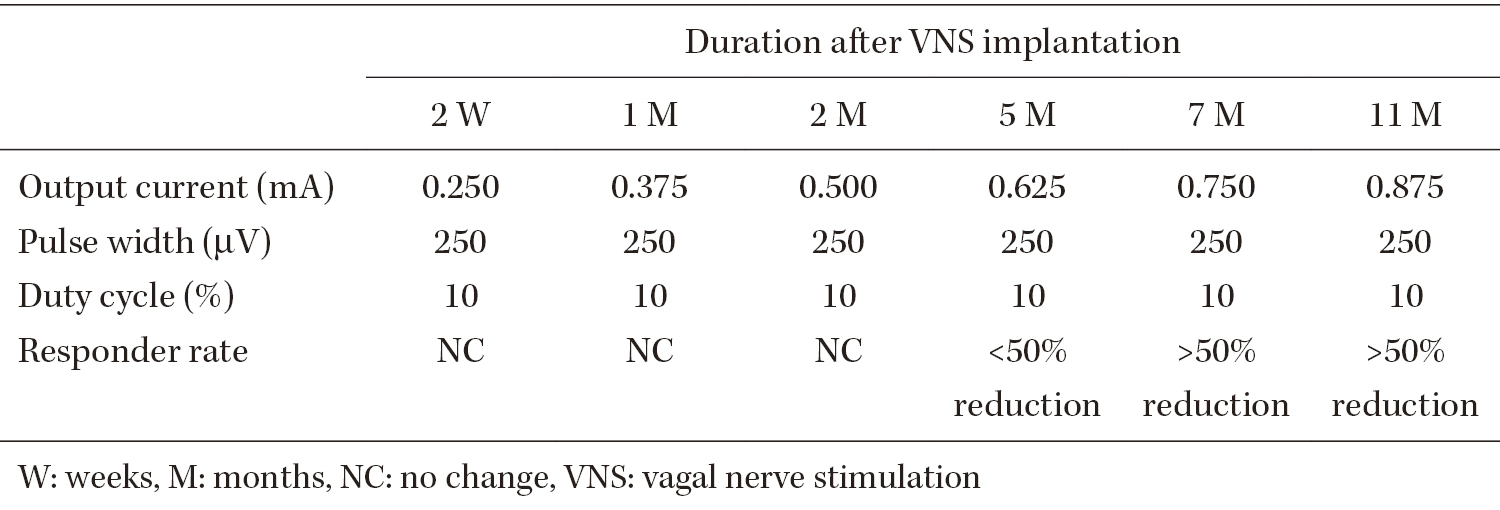- 著者
- Kyoko TATEBAYASHI Ichiro TAKUMI Takashi MATSUMORI Kimiyuki KAWAGUCHI Hidetoshi MURATA
- 出版者
- The Japan Neurosurgical Society
- 雑誌
- NMC Case Report Journal (ISSN:21884226)
- 巻号頁・発行日
- vol.10, pp.321-325, 2023-12-31 (Released:2023-11-11)
- 参考文献数
- 23
Epilepsy with eyelid myoclonia is a childhood-onset generalized epilepsy, which is more common in women. Over 90% of the patients continue antiseizure medications, especially valproate, and more than 60% of cases are refractory. The efficacy of vagus nerve stimulation in treating eyelid myoclonia is still unknown. Polycystic ovary syndrome is highly prevalent in women with epilepsy receiving valproate; nevertheless, no reports on the complication of polycystic ovary syndrome in women with epilepsy with eyelid myoclonia were found. In this report, a case of a woman with epilepsy with eyelid myoclonia who developed polycystic ovary syndrome while receiving valproate and underwent vagus nerve stimulation is described. A 26-year-old female patient has been administered valproate since the occurrence of generalized seizures at the age of 12 years and then developed polycystic ovary syndrome. When the dose of valproate was reduced as an adult, her epilepsy became intractable. Information from her mother led to a video electroencephalography re-evaluation, and she was finally diagnosed 15 years after onset. The patient underwent vagus nerve stimulation. In a short-term follow-up, she achieved >50% seizure reduction at low output currents of <1.00 mA. Polycystic ovary syndrome was cured 15 months after valproate withdrawal. There are three key points presented in this case: Vagus nerve stimulation therapy was useful for treating epilepsy with eyelid myoclonia with absence. Women with epilepsy with eyelid myoclonia taking valproate must be aware of the risk of polycystic ovary syndrome and monitor their menstrual cycles. Information from the family, such as home videos, helped with the diagnosis.
- 著者
- Akemi Kurisu Aya Sugiyama Tomoyuki Akita Ichiro Takumi Hitoshi Yamamoto Koji Iida Junko Tanaka
- 出版者
- Japan Epidemiological Association
- 雑誌
- Journal of Epidemiology (ISSN:09175040)
- 巻号頁・発行日
- pp.JE20220316, (Released:2023-02-25)
- 参考文献数
- 17
- 被引用文献数
- 2
Introduction: The burden of epilepsy is thought to be high but is difficult to measure. Very few studies in Japan have attempted to estimate prevalence and incidence rates of epilepsy in Japan.Methods: This retrospective cohort study used commercially collected nationwide insurance claims data from a cohort of 10M persons between 2012 and 2019 among those aged 0 to 74 years. Using the claims data, cases were identified, and incidence and prevalence rates were estimated.Results: A total of 9,864,278 persons were included. The average age was 34.5 (± SD 18.5) years. A total of 77,312 persons were diagnosed with epilepsy over the 8-year observation period with a prevalence rate of 6.0 per 1,000 with almost no difference by gender. The highest rates were seen among those aged 70-74 years; prevalence rates tended to rise with calendar year (5.4/1,000 in 2012, 6.0/1,000 in 2019). The incidence rate of epilepsy was 72.1 per 100,000 person-years with slightly higher rates seen among females. Incidence rates were highest at ages less than 12 months (199.8/100,000 person-years), followed by the eldest age group (70-74 years, 179.4/100,000 person-years)Conclusions: Understanding the magnitude of disease burden is the basis of determining health policies. In this study, the prevalence and incidence of epilepsy in Japan was shown based on the analysis results of a large-scale general population insurance claims data covering all over Japan.
